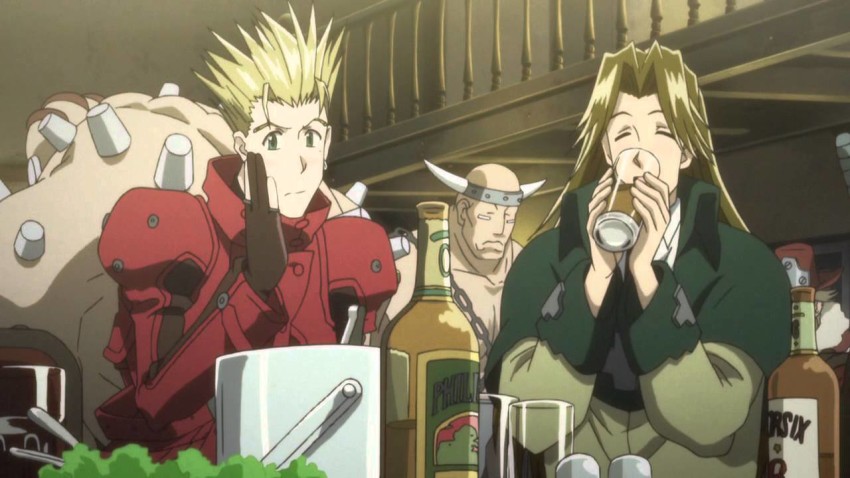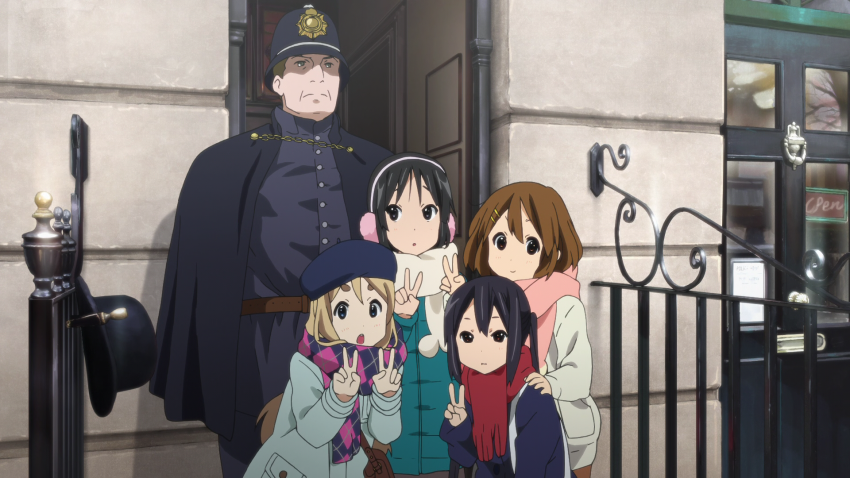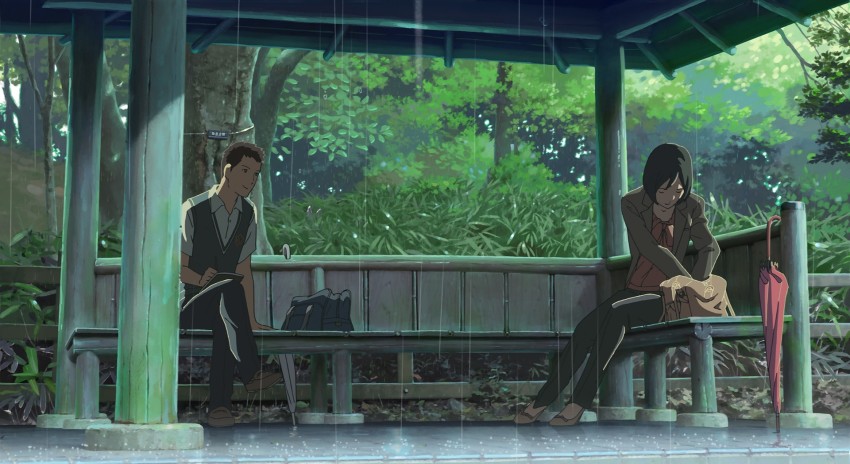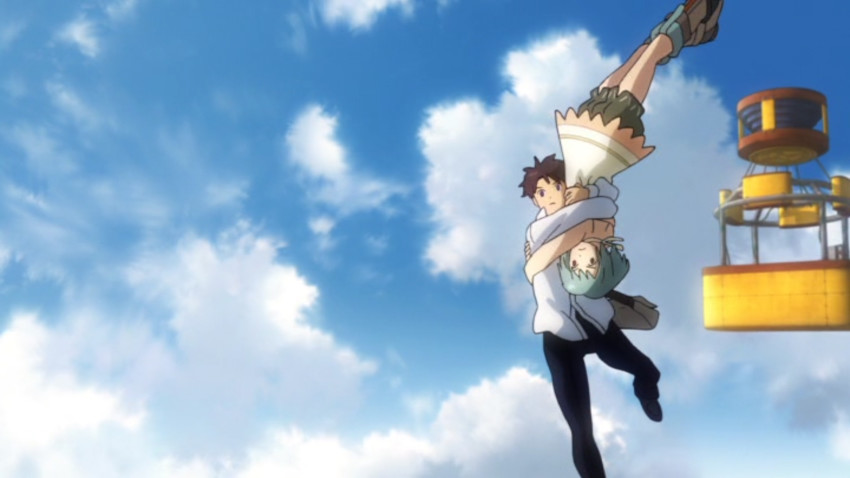Ten Years of Scotland Loves Anime (Part 1)
October 9, 2019 · 0 comments
By Jonathan Clements.
 Choose big eyes. Choose tentacles. Choose vampires. Choose ninja. Choose zombies. Choose cosplay. Choose samurai. Choose not to take whatever Disney doles out. Choose girls with guns and boys before flowers. Choose weird endings and wondering what the hell you just saw. Choose sitting in that cinema, watching the best that Japan has to offer. Choose your future, at Scotland Loves Anime.
Choose big eyes. Choose tentacles. Choose vampires. Choose ninja. Choose zombies. Choose cosplay. Choose samurai. Choose not to take whatever Disney doles out. Choose girls with guns and boys before flowers. Choose weird endings and wondering what the hell you just saw. Choose sitting in that cinema, watching the best that Japan has to offer. Choose your future, at Scotland Loves Anime.
To start as they meant to go on, in 2010, Edinburgh University threw a party for us that started ten minutes after I was supposed to be introducing a film in Glasgow. I remember stumbling out of the lecture hall where Satoshi Nishimura had just bigged up Trigun to an audience that included the Japanese consul, and tried to remember which city I was in.
Nishimura and his producer Shigeru Kitayama were our first guests at Scotland Loves Anime, enthusiastic about the weirdness of Glasgow, where Nishimura was thrilled that the ambulances sirens “all sounded just like in Thunderbirds,” and that supermarkets sold “an orange drink that is made in Scotland, from girders.” Interpreter Bethan Jones was already on hand in those early days to explain that, no, he had not misread the writing on the can.
Looking back over my notes from the first festival ten years ago, I see that many of the elements of a Scotland Loves Anime were already in place. French cosplayers had to be dissuaded from leaping onto the stage and dancing along with the closing credits of Haruhi Suzumiya. Michael Sinterniklaas, fated to be a regular dubbing director and actor in future festival screenings, was our Edinburgh guest. The audience was already troublesome, thanks to a lone giggler who snickered all the way through the sad bits in Professor Layton. The festival closed with a packed-out screening of Akira, and festival director Andrew Partridge staged the first of a seemingly unending series of revivals of the heckle-worthy Redline. Although, come to think of it, I think Redline was actually new that year.
 The first festival also saw the first Education Day, where industry guests squeezed into a conference room at the Edinburgh Film House and discussed elements of their craft. Nik Taylor, from Rockstar Games talked students through the design of Grand Theft Auto IV, while Oscar Wright, Conceptual Designer and Head Storyboard Artist on Scott Pilgrim vs the World (pictured), demonstrated the many things ripped off from anime in the film. The Education Days have become a regular feature of SLA in the years since, now held at the Edinburgh College of Art, are something of a secret element of the festival, presenting Scottish animation students with the chance to meet guests and jury members, and to hear presentations about their careers and productions.
The first festival also saw the first Education Day, where industry guests squeezed into a conference room at the Edinburgh Film House and discussed elements of their craft. Nik Taylor, from Rockstar Games talked students through the design of Grand Theft Auto IV, while Oscar Wright, Conceptual Designer and Head Storyboard Artist on Scott Pilgrim vs the World (pictured), demonstrated the many things ripped off from anime in the film. The Education Days have become a regular feature of SLA in the years since, now held at the Edinburgh College of Art, are something of a secret element of the festival, presenting Scottish animation students with the chance to meet guests and jury members, and to hear presentations about their careers and productions.
By the second festival, in 2011, Scotland Loves Anime was being listed in the Big Issue as the number-one Best Thing to Do in Scotland, ahead of a Bob Dylan concert at number 10, Snoop Dogg’s Glasgow performance at number eight, and the Aviemore International Porridge-Making Competition at number two.
 “I am glad we beat the porridge,” noted Aniplex producer Shuko Yokoyama, one of the Glasgow guests, in town with produce Yumi Sato to promote Aniplex’s short film Into the Forest of the Fireflies’ Light (pictured). Her film would also beat the competition in the first Judges’ Award, in a controversial jury decision that has reverberated ever since. As the jury chairman, I tried to take the film off the table in the first round of discussions, on the understanding that it was too short to compete with full-length features. The jury objected, saying they liked it for its brevity, and that if we didn’t want it in competition, we shouldn’t have put it on the slate. As a result, the 45-minute short wiped the floor with Letter to Momo and Keiichi Hara’s under-rated Colorful. Andrew Partridge had to break it to the latter film’s producer Shunsuke Oiji that his film hadn’t won, which was doubly difficult because he was sitting next to him at the time.
“I am glad we beat the porridge,” noted Aniplex producer Shuko Yokoyama, one of the Glasgow guests, in town with produce Yumi Sato to promote Aniplex’s short film Into the Forest of the Fireflies’ Light (pictured). Her film would also beat the competition in the first Judges’ Award, in a controversial jury decision that has reverberated ever since. As the jury chairman, I tried to take the film off the table in the first round of discussions, on the understanding that it was too short to compete with full-length features. The jury objected, saying they liked it for its brevity, and that if we didn’t want it in competition, we shouldn’t have put it on the slate. As a result, the 45-minute short wiped the floor with Letter to Momo and Keiichi Hara’s under-rated Colorful. Andrew Partridge had to break it to the latter film’s producer Shunsuke Oiji that his film hadn’t won, which was doubly difficult because he was sitting next to him at the time.
The star of the festival that year was Ryosuke Takahashi, the dapper, tweed-clad director of Armoured Trooper Votoms: The Pailsen Files.
“My real hobby is golf,” he confessed to the crowd. “And so when I was invited to this festival, the first thing I checked was how far away it was from St Andrews. Only an hour? I’m there!” He arrived at Scotland Loves Anime after a day puttering around the Old Course, and came loaded with golfy thoughts.
“Pailsen Files and golf have a lot in common,” he said, with a mischievous twinkle in his eye. “Both are the inheritors of long traditions. And both are quite boring to watch!”
By 2012, Scotland Loves Anime was no longer two weekends in October, but almost a fortnight of constant anime, with the Edinburgh Film house running evening screenings in the intermediate weekdays. Already known for UK premieres of big-name anime, this year’s festival managed a world exclusive, screening Ryosuke Nakamura’s Psychic School Wars a month ahead of its Japanese opening night.

With a reputation for first-look features and exclusive content, as not only guests, but even audience members from Japan at the twin sites of Glasgow and Edinburgh. One Japanese gentleman had travelled seven thousand miles to be at the European premiere of K-on the Movie (pictured), arriving two hours early just in case there was a queue. He observed that it was unheard-of in Japan for fans to enjoy the degree of access and informality permitted at Scotland Loves Anime, and begged the producers to run something similar on their home turf. This, however, seems unlikely to happen – the mere presence of Japanese fans at certain Glasgow events obliged the producers to exercise a greater degree of caution regarding activities that might seem entirely benign to the British – photographs were forbidden, signing was efficiently regimented and restricted to one item per person, and in one bizarre turn of events, plans to giveaway signed copies of the DVD were cancelled after the logistics turned into a form-filling nightmare.
Particularly for first-time viewers of the franchise, the K-on movie’s chief quality was its London-based middle act, in which the members of a Japanese high school music club blunder from Aldgate East, to Camden, to Hyde Park, to the South Bank and all points in between. Blink and you will miss subtle references for moments of rock history, such as the girls traversing the iconic zebra crossing at Abbey Road.
Director Naoko Yamada, clearly touched by the exuberant reaction, noted that certain moments had eluded the Japanese audience, such as a sequence with a dog poo bin, and a reference to the London Dungeon. She revealed that the production team wandered around London, trying to put themselves into the position of the girls in the band, and imagining how they would react to the situations and places they found.
Were there any experiences in London that weren’t included in the anime?
“Marmite,” breathed Yamada grimly. “I thought it was Nutella. It was there in the little heart-shaped jar, and it looked so cute and delicious. But…”
Scotland itself started to exert a subtle influence on the visiting guests.
 “I hate location hunting,” confessed Naoyuki Onda, the designer of Berserk (pictured), who had not left Japan before. “It’s so bothersome. I would rather be at work, working. But being here has shown me how important it can be. The first thing I noticed was the rain. But there are so many interesting faces here. We were at Holyrood Palace this morning, and there were so many things we had only seen before in books, like the tapestries. We knew what they looked like, but we didn’t know how they were hung.”
“I hate location hunting,” confessed Naoyuki Onda, the designer of Berserk (pictured), who had not left Japan before. “It’s so bothersome. I would rather be at work, working. But being here has shown me how important it can be. The first thing I noticed was the rain. But there are so many interesting faces here. We were at Holyrood Palace this morning, and there were so many things we had only seen before in books, like the tapestries. We knew what they looked like, but we didn’t know how they were hung.”
“And the bed!” agreed his producer Fuko Noda. “We’d never seen a real princess’s bed before, and we realised that, if anything, the one we had in Berserk was too big. We’d certainly change that if there were a follow-up.”
Onda and Noda discussed the pitfalls of making a film about a fantasy version of Europe, with inspirations that flipped between unreal demons and super-accurate period detail. But which period?
“The banquet scene was one we argued about,” noted Noda. “The director wanted a baked dolphin on the table, but we thought it was a step too far. Then he dug up a medieval cookery book that really did have a recipe for baked dolphin.”
This year there was a different controversy over the Judges’ Award, now universally known as the Golden Partridge, despite the protestations of the festival director. Mamoru Hosoda’s Wolf Children was disqualified from competition, as it had already been screened at the London Film Festival. That was good news for the Berserk movie, which won with a majority vote, but plainly Wolf Children would have easily carried away the trophy if it had been allowed to compete. Future festivals would relax the premiere-only requirement for films in competition, and allow a little bit of dissent with the introduction of the Audience Award, voted on not by a specialist committee, but by the punters in the cinema.
Scotland Loves Anime in 2013 opened with the earth-shattering UK premiere of Hideaki Anno’s Evangelion 3.0, and was highly touted in the Emirates in-flight magazine that autumn, which proclaimed it to be one of the top twenty things to be doing on the planet in October, beating both a belly-dancing competition and the Abu Dhabi camel races. It included nine European or UK premieres, including one film that had yet to appear in its native Japan. That was Little Witches Yoyo & Nene revealed as the Mystery Film in Glasgow, and placed in competition for the Judges’ Award in Edinburgh.
Masayuki Miyaji, one of a handful of graduates of the new talent training scheme in the last days of Studio Ghibli, was on hand to introduce the European premiere of his Fuse: Memoirs of the Hunter Girl. To a rapt audience at the Glasgow Film Theatre, he recounted his experiences as the timid youth who drew the short straw on Ghibli’s most dangerous responsibility – waking up Miyazaki from his afternoon naps – but also the priceless value of being able to learn at the feet of the master.
 Also in town was anime’s golden boy, Makoto Shinkai, on hand to introduce his short film The Garden of Words (pictured; kept out of competition after the Fireflies’ Light debacle). Appearing at both the Education Day at the Edinburgh College of Art lecture and a Q&A session after his film, Shinkai was unfailingly polite and engaging with his fans, and paid them the compliment of answering every question, no matter how odd, with a considered response. So while he happily spouted program specifications and animator jargon when describing his intricate tree-modelling and water effects, he was just as personable when fielding questions about whether or not he had a crush on the Urusei Yatsura actress Fumi Hirano, and the almost haiku-like: “Why trains?”
Also in town was anime’s golden boy, Makoto Shinkai, on hand to introduce his short film The Garden of Words (pictured; kept out of competition after the Fireflies’ Light debacle). Appearing at both the Education Day at the Edinburgh College of Art lecture and a Q&A session after his film, Shinkai was unfailingly polite and engaging with his fans, and paid them the compliment of answering every question, no matter how odd, with a considered response. So while he happily spouted program specifications and animator jargon when describing his intricate tree-modelling and water effects, he was just as personable when fielding questions about whether or not he had a crush on the Urusei Yatsura actress Fumi Hirano, and the almost haiku-like: “Why trains?”
“The thing is,” Shinkai conceded, “if you want to present a realistic impression of everyday Tokyo, you are going to be showing trains, and my animators are real train-spotters – very keen to get the precise models for the different lines, and to depict the experience of being onboard.” The trains, like the trees in Shinkai’s exquisite short, help the animator by depicting the things that an artist can’t show – the buffeting of passing carriages or the gusts of wind that add real solidity to the whole piece.
Behind the scenes, the festival continued to push its not-so-secret agenda of putting Scotland on the map for anime creators. At their own request Miyaji and his producer Kazuaki Takahashi were shown famous architecture, fed haggis and shown around Robert Owen’s landmark New Lanark industrial model town. Miyaji confessed that it was a dream come true for him to see a place poised on the edge of Scotland old and new, much like the Edo depicted in his Fuse. Makoto Shinkai, however, instead barricaded himself in his hotel room to complete his allotted word-count on his new novel. Duty first!
 The festival’s unquestionable hit, snagging both the Golden Partridge and the Audience Award, was Yasuhiro Yoshiura’s Patema Inverted (pictured), a feature-length sci-fi work about a girl who escapes her own underground world, only to discover that she is literally gravity-defying on the surface, and will float away into the sky unless anchored to something. In the wrong hands, this could have all too easily turned into My Girlfriend is a Party Balloon, but Yoshiura used it as a wonderful chance to experiment with shonky perspectives, vertiginous changes in angle, and a prolonged exercise in how boys and girls never quite see the world the same way round. For the judges, it was regarded as an ambitious, coherent film with negligible flaws and requiring no prior knowledge to enjoy it. For the audience, made to vote with a complex ratings system involving hundreds of coloured lolly-sticks and four paper bags, Patema Inverted scored consistently high on the Very Good and Good categories, with almost no haters.
The festival’s unquestionable hit, snagging both the Golden Partridge and the Audience Award, was Yasuhiro Yoshiura’s Patema Inverted (pictured), a feature-length sci-fi work about a girl who escapes her own underground world, only to discover that she is literally gravity-defying on the surface, and will float away into the sky unless anchored to something. In the wrong hands, this could have all too easily turned into My Girlfriend is a Party Balloon, but Yoshiura used it as a wonderful chance to experiment with shonky perspectives, vertiginous changes in angle, and a prolonged exercise in how boys and girls never quite see the world the same way round. For the judges, it was regarded as an ambitious, coherent film with negligible flaws and requiring no prior knowledge to enjoy it. For the audience, made to vote with a complex ratings system involving hundreds of coloured lolly-sticks and four paper bags, Patema Inverted scored consistently high on the Very Good and Good categories, with almost no haters.
That’s more than can be said for The Life of Budori Gusuco, a pious Buddhist parable about a talking blue cat who throws himself into a volcano. Despite the heavy-hitting director Gisaburo Sugii attached to the production, Budori Gusuco was only a hit with a scattering of Japanese Buddhists who already knew the story. Many other audience members pronounced it dreary and muddled, and accorded it the rare dismissal at SLA of no round of applause. That’s saying something – even Kevin Bacon got an ovation at one point, and all he did was show up in a mobile phone advert. The Life of Budori Gusuco has subsequently become something of a running joke at the festival, usually to refer to something so despised by the jury that it is thrown out of the window of the taxi on the way to the judges’ deliberations. This status has, in turn, turned it into a legend… it has its defenders, and contemporary SLA-goers refuse to believe it can really have been all that bad. They get their chance to find out in 2019, when the notorious film is enjoying a revival.
In 2014, BONES producer Masahiko Minami was in attendance at the Edinburgh leg of the festival, sporting a flashy Space Dandy jacket, and introducing two episodes of his absurdist sci-fi comedy, in which the entire cast periodically dies, gets turned into zombies, or otherwise faces a franchise-killing end, only to be reset to zero the following episode.
“We saw Space Dandy as a festival,” explained Minami. “We wanted different animators to come together in celebration, trying different genres and styles with the same basic cast.” Quizzed on the lead character’s obsession with the Boobies breastaurant, Minami confessed that Tokyo only had once branch of Hooters, but that trips to the franchise’s better-endowed American outlets had formed a crucial and tax-deductible exercise in research and development. His only regret, he said, with Space Dandy, was that they had never got around to their hot springs episode, because he had been looking forward to charging the company for all the research in that.
Minami had spent much of the previous day at Edinburgh Castle, where the Japanese-language audio guide had dragged him deep into Scottish history. “This is a town so embedded in so many stories,” he said. “Even the cobblestones in the street are an inspiration. Also, I’ve bought a lot of Scotch whisky, but I don’t think I can charge that to the company.” Edinburgh Castle would subsequently show up in a later episode of Space Dandy… as a spaceship.
Quizzed onstage about his film Giovanni’s Island, director Mizuho Nishikubo conceded that it had originally been intended as a live-action film production. Digital animation, bordering on the photo-real for the rolling waves off the island of Shikotan, frame a naturalist present-day sequence in which aging exiles from present-day Japan make a goodwill visit to the island where they were born, now part of Russian territory.
Nishikubo’s film, which included surreal excerpts from Kenji Miyazawa’s Night on the Galactic Railway as an attempt to court Japan’s blue-chip Buddhist audience attention, carried away the Judges’ Award that year, although much of the competition in this play-it-safe Ghibli-free year comprised instalments of long-running franchises, liable to scare off newcomers. (To be continued in part two…)
Jonathan Clements is the Festival Jury Chairman at Scotland Loves Anime. Nobody knows why.
Leave a Reply